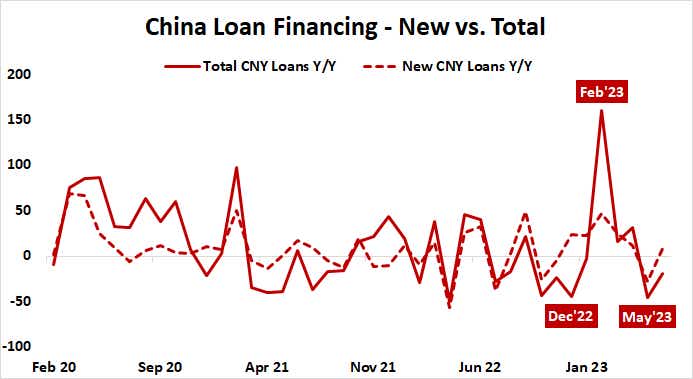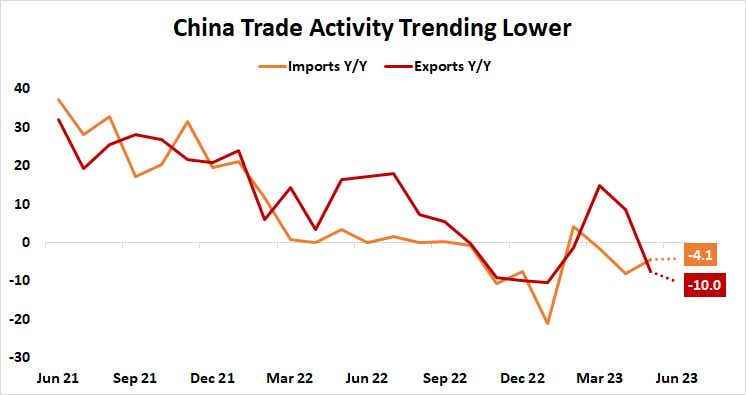China Woes Deepen as Trade Suffers Despite Stimulus

China Woes Deepen as Trade Suffers Despite Stimulus
By:Ilya Spivak
Weak Chinese trade data threatens markets just as global recession worries build
- China’s reopening after Covid lockdowns continues to disappoint.
- Beijing’s assorted economic stimulus measures are falling short.
- Downbeat trade data may amplify markets’ global recession fears.
China continues to struggle with the lingering hangover from its pandemic containment strategy.
This “zero COVID” approach locked down much of the economy until December 2022, when Beijing changed its mind and raced to reopen the world’s second-largest economy. Results have disappointed. A spurt of domestic demand juiced up growth in the first quarter as the service sector bloomed, but that fillip seems spent already. Official and private-sector PMI (purchasing managers index) surveys suggest services growth peaked in March, then slid to five-month lows by June.
Meanwhile, sharp bursts of catch-up growth in the U.S. and Eurozone—the East Asian giant’s most important export markets—had long since crested by the time Beijing decided to end mass quarantines. Worse still, China’s belated reopening drove supply chain diversification. Its share of global trade volumes has been falling since early 2021, hitting a three-year low at 11.2% in February 2023. That’s down from a peak of 15% in April 2020.
China’s stimulus efforts are falling short
Policymakers’ attempts at stimulus have underwhelmed so far. A grab-bag of various monetary measures—assorted interest rate reductions and capital injections—yielded only a modest pickup in financing growth. Meanwhile, house prices fell in May for the13th consecutive monthd espite measures to shore up the ailing property market. The share of cities reporting net price gains fell to 65.7% at the same time, marking a three-month low.

June’s trade figures are expected to offer still more negativity. Exports are seen falling 10% while imports decline 4.1% year-on-year, pointing to continued trouble with demand at home and abroad. It may turn out worse still. Data from Citigroup suggests Chinese economic data has increasingly underperformed relative to baseline forecasts since mid-April, warning that analysts’ models are too rosy and opening the door for continued disappointment.
Stock markets, Australian dollar may fall if China’s trade data disappoints
Soggy results would come at a time when the markets seem to be increasingly concerned with recession risk. Resurgent China might have helped cushion the global economy as the Fed leads a spirited disinflationary push, driving up borrowing costs and cooling activity. Data suggesting that conditions for the East Asian behemoth are trending in the wrong direction may amplify growth concerns and hurt cycle-sensitive assets, like stocks and the Australian dollar.

Ilya Spivak, tastylive head of global macro, has 15 years of experience in trading strategy, and he specializes in identifying thematic moves in currencies, commodities, interest rates and equities. He hosts Macro Money and co-hosts Overtime, Monday-Thursday. @Ilyaspivak
For live daily programming, market news and commentary, visit tastylive or the YouTube channels tastylive (for options traders), and tastyliveTrending for stocks, futures, forex & macro.
Trade with a better broker, open a tastytrade account today. tastylive, Inc. and tastytrade, Inc. are separate but affiliated companies.
Options involve risk and are not suitable for all investors. Please read Characteristics and Risks of Standardized Options before deciding to invest in options.
tastylive content is created, produced, and provided solely by tastylive, Inc. (“tastylive”) and is for informational and educational purposes only. It is not, nor is it intended to be, trading or investment advice or a recommendation that any security, futures contract, digital asset, other product, transaction, or investment strategy is suitable for any person. Trading securities, futures products, and digital assets involve risk and may result in a loss greater than the original amount invested. tastylive, through its content, financial programming or otherwise, does not provide investment or financial advice or make investment recommendations. Investment information provided may not be appropriate for all investors and is provided without respect to individual investor financial sophistication, financial situation, investing time horizon or risk tolerance. tastylive is not in the business of transacting securities trades, nor does it direct client commodity accounts or give commodity trading advice tailored to any particular client’s situation or investment objectives. Supporting documentation for any claims (including claims made on behalf of options programs), comparisons, statistics, or other technical data, if applicable, will be supplied upon request. tastylive is not a licensed financial adviser, registered investment adviser, or a registered broker-dealer. Options, futures, and futures options are not suitable for all investors. Prior to trading securities, options, futures, or futures options, please read the applicable risk disclosures, including, but not limited to, the Characteristics and Risks of Standardized Options Disclosure and the Futures and Exchange-Traded Options Risk Disclosure found on tastytrade.com/disclosures.
tastytrade, Inc. ("tastytrade”) is a registered broker-dealer and member of FINRA, NFA, and SIPC. tastytrade was previously known as tastyworks, Inc. (“tastyworks”). tastytrade offers self-directed brokerage accounts to its customers. tastytrade does not give financial or trading advice, nor does it make investment recommendations. You alone are responsible for making your investment and trading decisions and for evaluating the merits and risks associated with the use of tastytrade’s systems, services or products. tastytrade is a wholly-owned subsidiary of tastylive, Inc.
tastytrade has entered into a Marketing Agreement with tastylive (“Marketing Agent”) whereby tastytrade pays compensation to Marketing Agent to recommend tastytrade’s brokerage services. The existence of this Marketing Agreement should not be deemed as an endorsement or recommendation of Marketing Agent by tastytrade. tastytrade and Marketing Agent are separate entities with their own products and services. tastylive is the parent company of tastytrade.
tastyfx, LLC (“tastyfx”) is a Commodity Futures Trading Commission (“CFTC”) registered Retail Foreign Exchange Dealer (RFED) and Introducing Broker (IB) and Forex Dealer Member (FDM) of the National Futures Association (“NFA”) (NFA ID 0509630). Leveraged trading in foreign currency or off-exchange products on margin carries significant risk and may not be suitable for all investors. We advise you to carefully consider whether trading is appropriate for you based on your personal circumstances as you may lose more than you invest.
tastycrypto is provided solely by tasty Software Solutions, LLC. tasty Software Solutions, LLC is a separate but affiliate company of tastylive, Inc. Neither tastylive nor any of its affiliates are responsible for the products or services provided by tasty Software Solutions, LLC. Cryptocurrency trading is not suitable for all investors due to the number of risks involved. The value of any cryptocurrency, including digital assets pegged to fiat currency, commodities, or any other asset, may go to zero.
© copyright 2013 - 2025 tastylive, Inc. All Rights Reserved. Applicable portions of the Terms of Use on tastylive.com apply. Reproduction, adaptation, distribution, public display, exhibition for profit, or storage in any electronic storage media in whole or in part is prohibited under penalty of law, provided that you may download tastylive’s podcasts as necessary to view for personal use. tastylive was previously known as tastytrade, Inc. tastylive is a trademark/servicemark owned by tastylive, Inc.